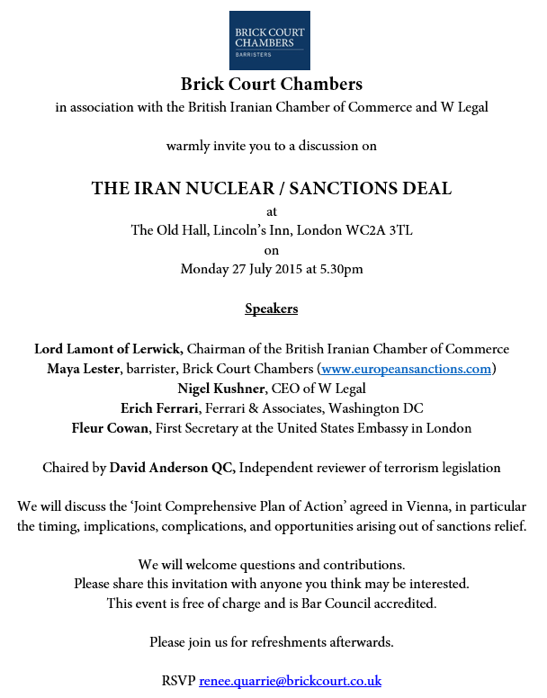Parsing Sanctions Relief Under The Joint Plan Of Action
By now, most if not all of Sanction Law’s regular readers will have at least glanced at the guidance issued by the Office of Foreign Assets Control on the sanctions relief being provided to Iran as part of the implementation of the Joint Plan of Action(JPA). Under the agreement, the P5+1 will suspend certain sanctions on Iran’s crude and petrochemical exports, auto industry, and the purchase or sale of precious metals. There is also a new Statement of Licensing Policy covering Iran’s civil aviation industry and plans for a channel to facilitate the purchase of humanitarian goods. In exchange, Iran will halt and in some areas roll back its nuclear program. Any easing of sanctions will be met with relief by Iran due to the dire state of its economy, even taking into account a slight improvement over the past six months. However, a close reading of the guidance and the Frequently Asked Questions reveals that the relief is limited in several key respects.
First, the vast majority of the restrictions being eased are secondary sanctions covering the actions of non-U.S. persons. The only exception is the new licensing policy for the export of U.S.-origin goods needed for the safety of Iran’s civil aviation industry. U.S. persons thus remain prohibited from conducting virtually any transactions with Iran. While not unexpected, the decision not to change any of the restrictions governing U.S. persons serves to reinforce the fact that the interim agreement does not represent a decisive shift in U.S. sanctions policy vis-à-vis Iran.
Second, the eased restrictions on Iran’s petrochemical industry are limited to removing secondary sanctions on exports and associated services. Given that the National Iranian Gas Company (NIGC) declared bankruptcy on November 16, relaxing the restrictions put in place by Executive Order 13622 and §1244(c)(1) of the 2013 National Defense Authorization Act is not insignificant. However, sanctions contained in §5(a)(6)(A) of the Iran Sanctions Act of 1996 as amended by the Iran Threat Reduction and Syria Human Rights Act of 2012, remain in place. This section threatens sanctions on any person who sells, leases, or provides to Iran’s petrochemical sector goods, services, technology, or support which has a fair market value of $250,000 or that during a 12-month period, have an aggregate fair market value of $1,000,000 or more. Iran’s petrochemical industry, as with all of its energy resources, is in desperate need of foreign investment. Under the Joint Plan of Action, it will still be prohibited.
Third, the requirement that revenue from Iranian oil sales be kept in escrow accounts in local currency and only used for bilateral trade remains in place. While under the JPA Iran will receive $4.2 billion from existing oil funds if it complies with certain benchmarks, any new revenue remains locked up abroad. This also represents a drop in the bucket in the context of the estimated $100 billion in foreign exchange assets that Iran holds abroad and can only partially access.
Fourth and perhaps most importantly, Question 12 of the FAQ makes it clear that there is a hard deadline for transactions conducted after the six month implementation timeline. Any transaction currently authorized under the JPA, conducted after the six month deadline, will be considered a sanctionable offense. Therefore, companies interested in the Iranian market have six months from yesterday to sign contracts, deliver or receive any goods or services, and send or receive payment without risking action by OFAC. This is a relatively short window –over the past several years, a majority of western firms have divested completely from Iran and will need to start almost from scratch. The real end date for firms wishing to deal could therefore be several weeks or even months before the actual deadline.
Many questions remain regarding the exact scope of the implantation agreement. Relief on the sale to or from of precious metals will not apply to “Restricted Funds” i.e. revenue from past or future sales of petroleum or petroleum products, or funds held by the CBI, with certain unstated exceptions. It’s therefore unclear as to the extent to which Iran would be able to reconstitute the so called “gas-for-gold” scheme which allowed Iran to repatriate the proceeds of its natural gas sales to Turkey. There is also little public information as to what form the proposed humanitarian channel will look like in practice. So even with the new information released yesterday, it’s still difficult to tell the extent to which Iran will benefit from the deal.
It is likely that Iran will try to widen the trickle of relief offered under the JPA into a broader rush into the Iranian market by foreign firms, even in contravention of existing sanctions. Whether they succeed will be determined in large part by the Treasury and State Departments’ ability to hold the line.



